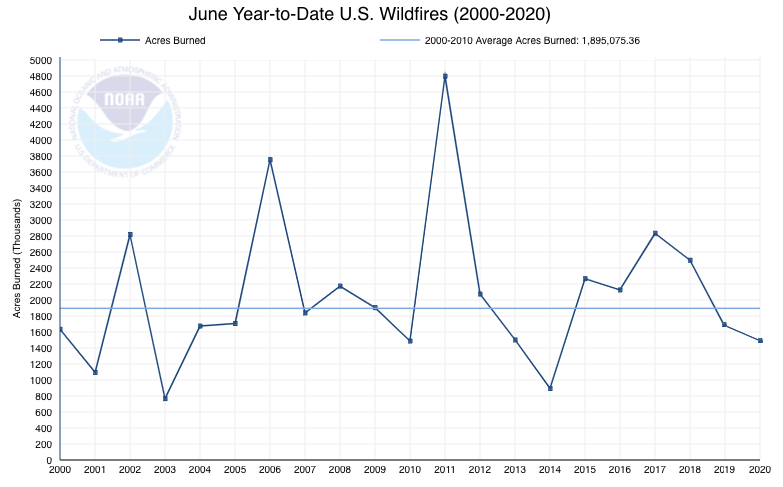Wildfires off to slow start in much of the West, but trouble expected starting in mid-July
Posted on 27 July 2020 by Guest Author
This is a re-post from Yale Climate Connections by Jeff Masters
Wildfires burned much less acreage in the U.S. than average during the first half of the year, but with hot and dry conditions expected over much of the nation in the coming months, fire activity is likely to ramp up.
The National Interagency Fire Center, or NIFC, reports that approximately 1.5 million acres burned in the U.S. from January through June. This is 60% of the 2010-2019 average of 2.4 million acres and puts 2020 in a virtual tie for the fourth-lowest acreage burned by this point in the year. NIFC records extend back to 2000.
Trouble is still expected as the peak season for wildfire danger arrives in July. As summarized at Carbon Brief and Climate Signals, recent decades have brought a significant increasing trend in the number of large fires and the total area burned per year in the U.S. In the West, human-caused climate change has been directly linked to drier conditions and increases in forest fire activity. At the same time that climate change is amplifying fire risk, the number of people living in known fire-prone areas (the wildland-urban interface) has sharply increased, compounding the threat to people and property.
 Figure 1. Total U.S. acreage burned in wildfires during the January-June period, for the years 2000-2020. (Image credit: NOAA)
Figure 1. Total U.S. acreage burned in wildfires during the January-June period, for the years 2000-2020. (Image credit: NOAA)
Arizona hit hard by wildfires in June
In Arizona, in contrast to the rest of the West, three of the top 10 largest fires in state history ignited in June. According to Inciweb, the Bush Fire, which started when a vehicle fire spread to nearby forests just northwest of Phoenix, had burned 193,000 acres by July 3, making it the state’s fifth-largest fire on record. That fire has been contained. The lightning-caused Bighorn Fire (78% contained on July 8), located just north of Tucson, has burned 119,000 acres, the eighth-largest fire in state history. And in the forest along the North Rim of the Grand Canyon, the human-caused Magnum Fire (88% contained on July 8) has burned 71,450 acres, putting it in a virtual tie for being the state’s tenth-largest fire on record. Evacuations were ordered for all three of those Arizona fires.
June is normally a very dry month in Arizona, with a statewide average precipitation of 0.29 inches, but during June 2020, most of the state received less than 5% of its normal precipitation. The fire danger in Arizona is expected to ease by mid-July, when the rains of the southwest U.S. monsoon typically ramp up.
 Figure 2. Wildfire outlooks for July through October 2020, as updated on July 1. (Image credit: NIFC Predictive Services)
Figure 2. Wildfire outlooks for July through October 2020, as updated on July 1. (Image credit: NIFC Predictive Services)
Forecast for higher wildfire risk in July, August, and September in the West
July begins the core of the western U.S. fire season, and in its July 1 monthly outlook, NIFC predicted an expansive area of above-average fire potential in July, August, and September across much of the West: Temperatures there have been above average in recent months with below-average precipitation. Much of the Southeast, in contrast, has been wet, so below-average fire potential is predicted across that region.
Drought continued to slowly intensify and expand across the Great Basin and Central Rockies in June (Figure 3). The Northern Rockies also experienced drought development and expansion across southern and eastern Montana and the Dakotas. All of these areas are expected to be at increased risk of wildfires as summer progresses.
 Figure 3. Drought conditions in the U.S. on June 30, 2020, from the July 2 release of the U.S. Drought Monitor product. (Image credit: U.S. Drought Monitor)
Figure 3. Drought conditions in the U.S. on June 30, 2020, from the July 2 release of the U.S. Drought Monitor product. (Image credit: U.S. Drought Monitor)































 Arguments
Arguments






























Meanwhile I was surprised to hear of the fires in Russia until I read this ... "7 days ago - On Monday, Russian officials said fires had destroyed 1.2 million hectares of forest in Russia, saying this figure “is a quarter less than a year ago”, independent ..."
Temperatures in Siberia have exceeded 100 F while record snow in Norway.
Global temperature discombobulation.